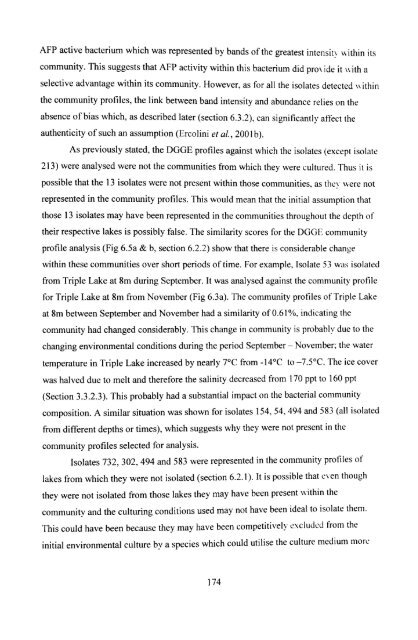ý.,,: V. ý ýý . - Nottingham eTheses - University of Nottingham
ý.,,: V. ý ýý . - Nottingham eTheses - University of Nottingham
ý.,,: V. ý ýý . - Nottingham eTheses - University of Nottingham
Create successful ePaper yourself
Turn your PDF publications into a flip-book with our unique Google optimized e-Paper software.
AFP active bacterium which was represented by bands <strong>of</strong> the greatest intensit\ within its<br />
community. This suggests that AFP activity within this bacterium did pros ide it with a<br />
selective advantage within its community. However, as for all the isolates detected ww ithin<br />
the community pr<strong>of</strong>iles, the link between band intensity and abundance relies on the<br />
absence <strong>of</strong> bias which, as described later (section 6.3.2), can significantly affect the<br />
authenticity <strong>of</strong> such an assumption (Ercolini et al., 2001 b).<br />
As previously stated, the DGGE pr<strong>of</strong>iles against which the isolates (except isolate<br />
213) were analysed were not the communities from which they were cultured. Thus it is<br />
possible that the 13 isolates were not present within those communities, as they were not<br />
represented in the community pr<strong>of</strong>iles. This would mean that the initial assumption that<br />
those 13 isolates may have been represented in the communities throughout the depth <strong>of</strong><br />
their respective lakes is possibly false. The similarity scores for the DGGE community<br />
pr<strong>of</strong>ile analysis (Fig 6.5a & b, section 6.2.2) show that there is considerable change<br />
within these communities over short periods <strong>of</strong> time. For example, Isolate 53 was isolated<br />
from Triple Lake at 8m during September. It was analysed against the community pr<strong>of</strong>ile<br />
for Triple Lake at 8m from November (Fig 6.3a). The community pr<strong>of</strong>iles <strong>of</strong><br />
Triple Lake<br />
at 8m between September and November had a similarity <strong>of</strong> 0.61 %, indicating the<br />
community had changed considerably. This change in community is probably due to the<br />
changing environmental conditions during the period September - November; the water<br />
temperature in Triple Lake increased by nearly 7°C from -14°C to -7.5°C.<br />
The ice cover<br />
was halved due to melt and therefore the salinity decreased from 170 ppt to 160 ppt<br />
(Section 3.3.2.3). This probably had a substantial impact on the bacterial community<br />
composition. A similar situation was shown for isolates 154,54,494 and 583 (all isolated<br />
from different depths or times), which suggests why they were not present in the<br />
community pr<strong>of</strong>iles selected for analysis.<br />
Isolates 732,302,494<br />
and 583 were represented in the community pr<strong>of</strong>iles <strong>of</strong><br />
lakes from which they were not isolated (section 6.2.1). It is possible that even though<br />
they were not isolated from those lakes they may have been present within the<br />
community and the culturing conditions used may not have been ideal to isolate them.<br />
This could have been because they may have been competitively excluded from the<br />
initial environmental culture by a species which could utilise the culture medium more<br />
174
















